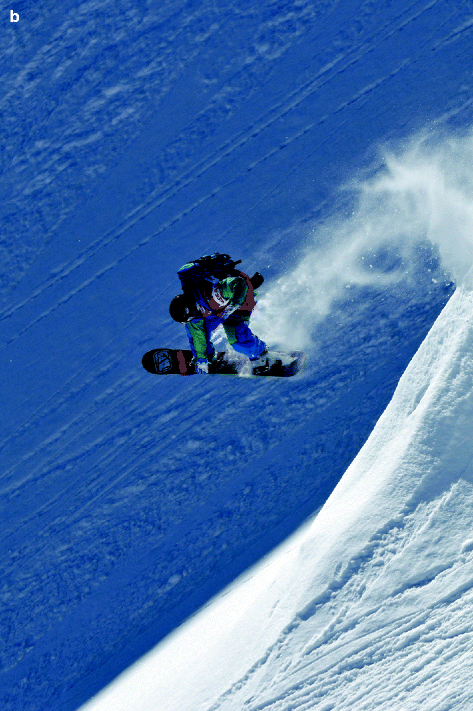
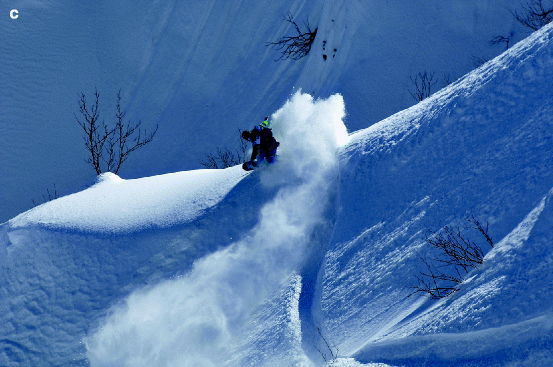
Fig. 3.1
Skier and snowboarder at the backcountry setup (By David Carlier)
Alpine Skiing
Alpine skiers use two skis attached to plastic ski boots via releasable binding systems. Ski poles are used to aid balance. The boot and binding should really be regarded as a single interface that transmits forces in both directions between the skier and the ski. Many different types of ski binding are available, all with subtle differences. All modern ski bindings involve a safety system which can be adjusted so that the binding releases at different preset force levels depending on the individual characteristics of the skier and their specific preferences. The bindings are also fitted with a braking system such that if the ski detaches from the boot, brake arms are activated. This function reduces the risk of a runaway ski sliding down the mountain causing injury. There is a huge variety of skis, boots, and bindings available depending on individual skiers’ preferences on cost, performance, comfort, and appearance. In the early 1990s, a fundamental equipment change took place with the introduction of carving skis. Compared to older traditional skis which were long and relatively thin, carving skis have an hourglass shape with a wide tip and tail and a narrow waist. This improves the turning performance of the skis and in general makes them much easier to maneuver [1].
As a result, carving skis have helped to revive the popularity of skiing in the face of competition from snowboarding and have subsequently lead to the development of other ski designs such as twin tips which further broaden the performance spectrum.
Snowboarding
In contrast to Alpine skiers, snowboarders are attached to a single wide board by non-releasable bindings. The snowboard stance is angled relative to the board unlike Alpine skiers who face the same direction as their skis. About 95 % of snowboarders wear softer boots than Alpine skiers [2]. These aim to combine functionality with comfort. Harder plastic boots are used by a small minority (who prefer improved maneuverability at the cost of a small loss of comfort). Various binding systems are available including step-in plate bindings, strap, and flow designs. In general, snowboarders release one boot from its binding when using most lift systems. The majority of snowboard bindings have neither a release function nor an inbuilt braking system. Expert opinion has concluded that the biomechanics of snowboarding indicate that a releasable binding system is of no benefit to the majority of recreational snowboarders [3]. However, the potential exists for a runaway board if both boots are out of the bindings and the boarder loses control of their board. An extendable leash can be attached to the board in order to reduce this risk. The relatively recent advent of split snowboards (where the snowboard divides into two fat skis to which climbing skins can be attached) allows snowboarders the opportunity to explore the backcountry, previously the exclusive domain of skiers.
Equipment Common to Both Sports
In order to ski and snowboard in comfort in Alpine environments, skiers and snowboarders commonly wear layered outdoor clothing in order to be able to regulate their temperature according to their level of activity and the prevailing weather conditions. Outer clothing layers need to be both windproof and waterproof, and many different fabrics are available. Clothing layers near to the body should be able to wick moisture away from the body. Ambient temperatures can be extremely low which, combined with wind chill, can lead to a significant risk of hypothermia. Additional protection is needed in such circumstances including frostbite protection for the face, nose, and ears. Specific face masks are available for this purpose.
Helmets
The popularity of helmets among snow sport enthusiasts has increased considerably in recent years. The deaths of celebrities such as actress Natasha Richardson (after a seemingly innocuous fall while skiing in March 2009) inevitably lead to considerable media coverage and can significantly influence the use of helmets on the slopes [4]. Helmet design has improved considerably, and what was once viewed as a geeky piece of equipment has now attained a cool status. In America, currently about 60 % of all skiers and snowboarders now wear a helmet, and in Switzerland, the figure is almost 80 % [5]. Modern helmets provide superior comfort, ventilation, and attractive graphics (see www.skihelmets.com). They also allow the integration of an ever increasing number of modern devices such as helmet cams and portable music players/radios.
Not only should a helmet fit correctly, but it is imperative that it meets one of the three accepted manufacturing standards for snow sport helmets. These are CEN 1077, ASTM 2040, and Snell RS 98. All set minimum standards for impact protection from both blunt and sharp objects at prescribed speeds. To meet the standards for CEN 1077, for example, a helmet containing a simulated head must be able to withstand a drop from 1.5 m onto a flat anvil. The peak acceleration imparted to the “head” must not exceed 250 Gs. Helmets must also survive a drop from 0.75 m onto a conical metal punch, simulating the impact from a tree branch or ski pole.
There is now a large body of evidence supporting the view that wearing a helmet reduces the risk of sustaining a head injury by up to 60 % [6–9]. While the majority of this evidence to date concerns minor or moderate head injuries, recent American data has also shown a positive association between helmet use and a reduction in both skull fractures [10] and serious intracranial injuries [11].
Thankfully the actual risk of sustaining a potentially serious head injury is extremely low (approximately 24,000 mean days between injuries [11]). While helmet use is mandatory for competitive skiers and snowboarders, the consensus view of experts such as the International Society for Skiing Safety is that the overall risk of head injury is not high enough to make helmet use mandatory for all recreational users. Others disagree however [12], and this debate is certain to continue for some time [13, 14].
At present there is no evidence that wearing a helmet reduces the risk of traumatic death on the slopes, and those who wear a helmet must be aware that it does not make them invincible. It has been argued that helmet wearers may take more risks and ski/board faster than non-helmet wearers (the so-called risk compensation theory). The evidence to date on this is small but conflicting [15, 16].
Many of the arguments for not wearing a helmet have been questioned by recent research. For example, there is no evidence that helmets interfere significantly with vision or hearing, or that they place excessive force on the neck during an accident [8, 17–19]. Helmets that have been involved in a significant impact such that the physical integrity of the helmet has been damaged should be replaced.
Miscellaneous Equipment
Adequate eye protection is essential as Alpine areas have high levels of UV light. Sunglasses and goggles provide UV protection as well as enhancing the users’ perception of physical terrain when traversing in bright or flat light. In general, sunglasses are preferred on calm sunny days, whereas goggles provide additional protection in more stormy weather. Goggles are however liable to fogging up, and adequate ventilation systems are required to prevent this.
Many skiers and snowboarders now routinely use portable digital music players to enhance their experience on the slopes. In addition, a variety of portable cameras have emerged specifically for the snow sport market. These can take a variety of still and video images along with audio recording and may be fitted to clothing, helmets, or even goggles. Indeed some modern goggles now offer integrated GPS systems. Care should be taken with all these items to ensure the user is not distracted by them from paying attention on the slopes.
Off-Piste (Backcountry) Equipment
Skiing or snowboarding out with the boundaries of recognized ski areas requires high levels of skill, knowledge of snow and mountain conditions, and the ability to navigate and survive independently. In addition to the standard equipment required for on-piste activities, backcountry skiers and boarders should carry supplementary equipment to assess and manage the risks and consequences of avalanche. This includes avalanche transceivers, probes, shovels, and airbag systems. Regular training in avalanche search techniques is recommended as time is a critical factor in avalanche survival [20]. Far too many potentially preventable avalanche deaths continue to occur every year [21]. Adequate communications, navigational equipment, and survival food/gear are required along with the skills to use them appropriately. While modern devices such as mobile phones and GPS units can greatly aid the backcountry enthusiast, overreliance on them should be avoided – GPS signals and batteries can both deteriorate unexpectedly. Participation in a specialist backcountry education program is highly recommended as is the use of a professional guide in unfamiliar areas. Those traveling abroad must read the small print of their insurance policy and ensure that it provides adequate cover should (potentially very expensive) rescue be required. Figure 3.2a, b shows a backcountry skier in a self-selected route and high jump. It is important to know how to land these high jumps to avoid major injuries. In Fig. 3.2b, a full-face helmet is almost mandatory in these types of stunts. A personal backpack would contain all the above-mentioned equipment.
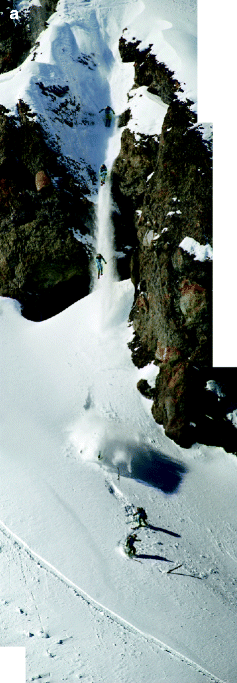
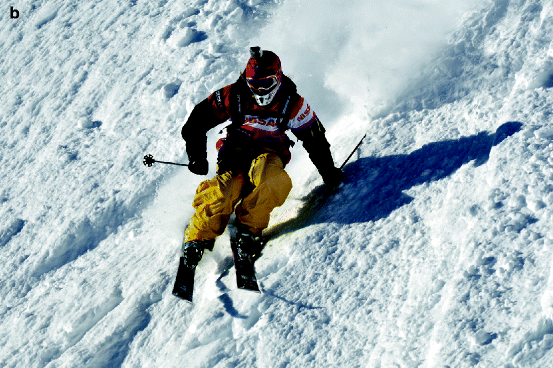


Fig. 3.2
(a) A skier lands badly, loose his skis but skis away from it… (b) Skier at the Freeride World Tour. Pay attention to full-face helmet, HD head-mounted camera. There is also full body armor underneath outfit (By David Carlier)
Injury and Fatality Rates and Specific Types of Injury Related to Each Sport
Overall Injury Risk
Like most outdoor activities, skiing and snowboarding are associated with a risk of injury. The current risk of a snow-sport-related injury on recreational slopes is between 2 and 4 injuries per 1,000 participant days [22], much lower than most people imagine. Indeed, the risk is much lower than that seen in other popular sports such as football and rugby and has fallen steadily over recent years [23]. Improvements in equipment, ski area design and maintenance, and piste preparation have all contributed to this improvement [23].
There is some variation in the absolute injury rate seen between different studies. This usually relates to the individual design of the study. Those that rely on self-reported injuries not surprisingly tend to result in higher injury rates as individuals are likely to report every single minor injury that they sustain. In contrast, at the other end of the scale, hospital-based studies tend to see a smaller percentage of all injuries sustained and therefore report a lower rate [24]. The middle ground is occupied by studies that rely on ski patrol or mountain clinic data, and these generally give a more accurate reflection of overall injury rate. Nevertheless, some skiers and snowboarders do not seek medical attention near the slopes after their injuries, preferring to either self-treat or return home to seek help in a more familiar setting. This so-called bypass effect occurs to some degree in all injury studies, although its effect is generally believed to be less than 10 % [2, 25].
Risk of Death on the Slopes
The risk of sustaining a traumatic death from participating in snow sports is even lower at one death per 1.57 million participant days [26]. This equates to approximately 39 traumatic deaths per year in the USA out of a total of almost 60 m participant days (source: www.nsaa.org). As with the risk of injury, the risk of dying from skiing or snowboarding is much lower than that of other popular recreational activities such as swimming and cycling [26]. Nevertheless, snow-sport-related deaths usually attract disproportionate degree of media attention.
The commonest cause of a traumatic snow-sport-related death is a high-speed collision with a static object such as a tree, pylon, or another person [27, 28]. Many of these deaths involve injury to the head either in isolation or with other injuries [28].
Nontraumatic causes of death on the slopes include ischemic heart disease, hypothermia, and medical events such as acute severe asthma attacks [27]. A less frequent but nevertheless important mechanism of death is the so-called non-avalanche-related snow immersion death (NARSID), also known as a “tree well death” [28, 29]. In this scenario, skiers and snowboarders fall into a hidden pit underneath a tree. This is a particular risk when riding between trees either on the lifts or to the side of marked pistes. Unless the event is witnessed, self-extrication from the tree well is extremely difficult. The trapped individual tends to cause more snow to fall into the pit as they struggle to try to free themselves. Death usually results either from hypothermia or asphyxiation from snow falling in [30].
Injuries from Alpine Skiing
Overall Injury Risk
The risk of injury from recreational Alpine skiing is generally accepted to be between 1 and 2 injuries per 1,000 participant days [22, 31]. This rate has decreased considerably since the 1970s [23]. This is largely due to safety advances in equipment design such as the development of releasable ski bindings and ski brakes. Prior to release bindings, fractures of the lower leg in particular were common as twisting forces were regularly transmitted unmitigated from the ski up to the lower leg. Since their introduction, properly set and maintained bindings have been shown to significantly reduce the risk of lower leg fracture. Nevertheless, Alpine skiers are still more likely to injure their lower rather than their upper limb. The knee joint is the single commonest site of injury among skiers. Most of these injuries are soft tissue/ligamentous in nature.
Injury Classification
The breakdown of Alpine ski injuries by type is shown in Figs. 3.3 and 3.4. Muscle and ligament strains and sprains account for almost half of all injuries Fig. 3.5. The fracture rate from Alpine skiing is approximately 19 % [25]. Common sites of fracture include the clavicle, proximal humerus, and tibia. Lacerations may occur as a result of direct impact with objects such as rocks, pylons, and snow fences. Ski edges are also sharp and may inflict nasty wounds. Contusions of varying magnitude result from collisions either with the snow surface or other objects. Joint injuries usually affect either the thumb or the shoulder joint after falling onto an outstretched hand. As more and more skiers enter terrain parks seeking aerial thrills, there has been a slow but steady rise in the incidence of spinal injuries.
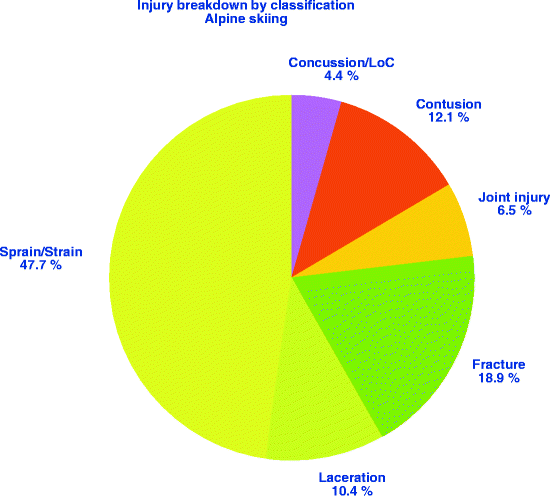
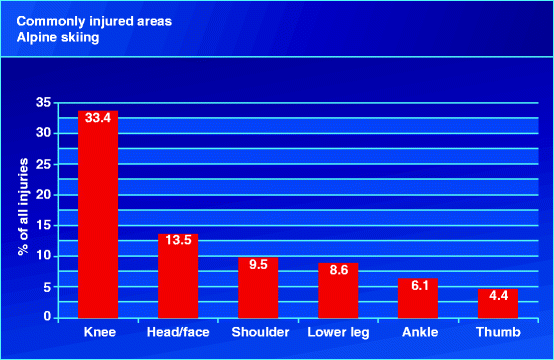
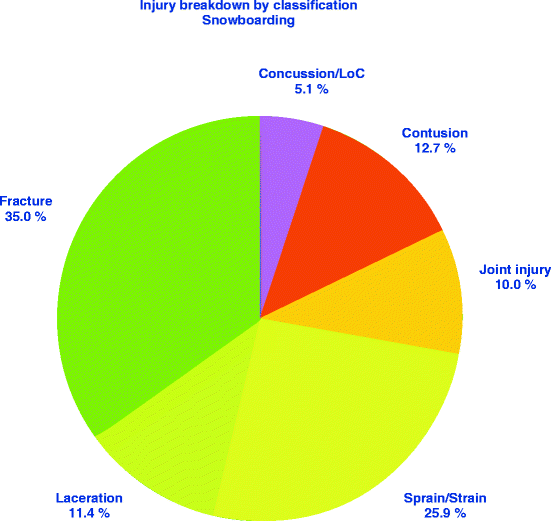

Fig. 3.3
Alpine skiing – injury classification

Fig. 3.4
Common injuries – Alpine skiing

Fig. 3.5
Snowboarding – injury classification
Injuries from Snowboarding
Overall Injury Risk
The risk of injury from snowboarding is generally regarded to be about twice that of Alpine skiing and currently stands at between 2 and 4 injuries per 1,000 participant days [31]. Snowboarders are more likely to injure their upper limb than their lower limb [25]. Learning to balance while fixed by both feet to a single board is a critical skill to develop. Unlike skiers, in the event of loss of balance, snowboarders cannot step out a leg to regain balance. As a result, falls due to loss of balance are frequent, and not surprisingly beginner snowboarders are at highest risk. Off-balance falls on a snowboard generally lead to an instinctual reaction of outstretching the hand to break the fall. This places the upper limb, and the wrist joint in particular, at high risk of injury [32].
Injury Classification
The breakdown of snowboarding injuries by type is shown in Figs. 3.6 and 3.7. The fracture rate among snowboarders is twice that of Alpine skiers [25], and the high rate of wrist fractures (up to 33 % of all injuries [33]) largely accounts for this. Muscle and ligament strain/sprains are still common as are contusions from off-balance falls. Snowboarders suffer a higher rate of shoulder joint injuries due to an increased tendency to fall onto the upper limb [25]. Ever since its inception, snowboarding has been associated with jumps and other aerial maneuvers. These activities are associated with a relatively small but definite risk of injury to the spine [34–36].
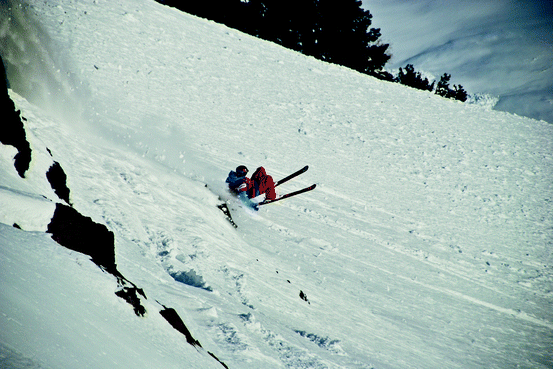

Fig. 3.6
A skier lands from a high jump with knee hyper-flexed which may result in injures to menisci/knee ligaments (by David Carlier)
Injuries Among Professional Skiers and Snowboarders
Recent research has highlighted the high risk of injury among professional skiers and snowboarders [37–40]. The rate of injury among professionals has been calculated to be as high as 17 injuries per 1,000 ski runs [38]. Extrapolation of this data indicates that the injury rate among professionals is approximately three times that of recreational participants [41]. While many of the injuries sustained are similar to those seen among recreational users, in general the incidence and severity of individual injuries is higher [39]. Almost one-third of all injuries among professional athletes were classified as severe, leading to an absence from participation of more than 28 days [39]. The knee is the commonest injury area among competitive Alpine skiers and snowboarders [38, 39, 41]. Having now identified the scale of the problem, the challenge for the FIS and national teams is to address this issue, balancing the potential conflict between performance and safety. Retrospective video analyses may help identify specific injury mechanisms among elite athletes [42].
Injuries Sustained in the Backcountry
There is no reliable data available specifically relating to the issue of backcountry injuries compared to on-slope injuries. Many backcountry users evacuate themselves to healthcare providers of their choice making study design challenging. Moreover, accurate assessment of the population at risk in the backcountry is extremely difficult to calculate. Those injuries that do come to the attention of ski physicians indicate that backcountry users are susceptible to a similar range of injuries as other recreational users. In general, the injuries sustained tend to be less severe and less frequent, reflecting the higher ability levels in this group [2].
Injuries by Anatomical Area
Lower Limb Injuries
Knee Injuries
Injuries to the knee joint account for about one third of all skiing injuries. Most of these are minor soft tissue sprains. The medial collateral ligament (MCL) is commonly injured as a result of valgus twist to the knee as the ski unintentionally splays the lower leg outward, thus stressing the knee joint. Clinically, an MCL injury is suggested by the mechanism and description of the fall and is often associated with non-release of the binding. There is localized tenderness over the ligament, and stress testing may demonstrate some laxity in grade two and three injuries. The vast majority of grade one and two injuries will settle with conservative treatment. More aggressive treatment is often required for grade three injuries to permit return to sport.
The most serious soft tissue injury to the knee involves damage to the anterior cruciate ligament (ACL). This important ligament may be injured in isolation or in combination with other structures.
There are several documented mechanisms of ACL injury in skiing. Before the advent of carving skis, the commonest mechanism involved a backward twisting fall (Fig. 3.7). In this scenario (also known as the “phantom foot” mechanism), the large rear tail of the ski behind the binding acts as a twisting lever across the knee joint, ultimately breaking the ACL [43]. Modern carving skis have a much smaller rear tail which reduces this risk. The commonest ACL injury mechanism currently is thought to be a forward twisting fall [44] with the knee flexed. The ACL can also be injured when a skier lands after a jump on the tail of the skis. The rear of the ski boot pushes the tibia forward relative to the femur causing ACL damage [45] with the knee hyperextended.
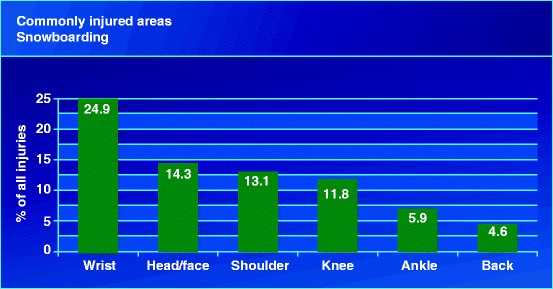

Fig. 3.7
Common injuries – snowboarding
Clinically, skiers report hearing or feeling a “pop” or “snap” sensation, and the knee swells rapidly usually within the first 2 h of injury. Diagnosis may be made clinically although MRI is frequently used to ascertain the degree of damage to the ACL and associated structures.
While it is possible to ski without an ACL, this requires considerable effort and physiotherapy input to maintain stabilizing knee muscle bulk and proprioception. Most orthopedic surgeons recommend ACL reconstruction for those who wish to ski at or above an intermediate level.
No studies have yet shown that the wearing of a knee brace provides primary protection against ACL injury while skiing. There is some evidence that a custom knee brace can reduce the incidence of repeat injury after ACL surgery [46].
Knee injuries among snowboarders are much less common and usually result either from direct trauma to the anterior aspect of the knee during a fall or twisting injuries, most commonly when one foot is out of its respective binding. This most frequently happens when the snowboarder is using a surface or chairlift. If the board catches an edge at this time, significant twisting force can be applied to the leg still attached as the binding has no release function. Despite this, most experts agree that releasable snowboard bindings offer little protection to the average snowboarder and in fact inadvertent release may be more of a danger.
Lower Leg Injuries
Before the introduction of releasable ski bindings, fractures of the lower leg were the commonest injury to befall skiers. These injuries can still occur when the binding fails to release and can be subdivided into twist and forward bend injuries depending on the mechanism of fall (Fig. 3.8). The use of properly maintained and set bindings greatly reduces (although does not completely eliminate) this risk.
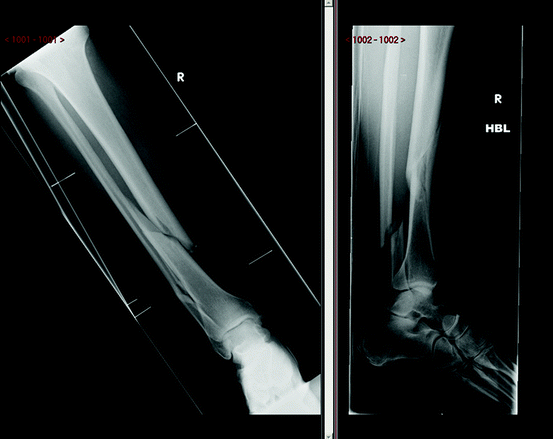

Fig. 3.8




Spiral lower leg fractures from Alpine skiing
Stay updated, free articles. Join our Telegram channel

Full access? Get Clinical Tree








